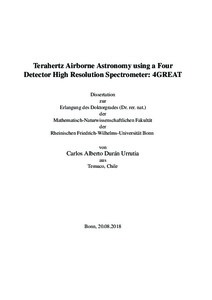Durán Urrutia, Carlos Alberto: Terahertz Airborne Astronomy using a Four Detector High Resolution Spectrometer: 4GREAT. - Bonn, 2018. - Dissertation, Rheinische Friedrich-Wilhelms-Universität Bonn.
Online-Ausgabe in bonndoc: https://nbn-resolving.org/urn:nbn:de:hbz:5n-52866
Online-Ausgabe in bonndoc: https://nbn-resolving.org/urn:nbn:de:hbz:5n-52866
@phdthesis{handle:20.500.11811/7683,
urn: https://nbn-resolving.org/urn:nbn:de:hbz:5n-52866,
author = {{Carlos Alberto Durán Urrutia}},
title = {Terahertz Airborne Astronomy using a Four Detector High Resolution Spectrometer: 4GREAT},
school = {Rheinische Friedrich-Wilhelms-Universität Bonn},
year = 2018,
month = dec,
note = {After the Herschel Space Telescope ceased operations in 2013, the astronomical community has been lacking access to those parts of the terahertz spectrum that are not visible from ground-based observatories. The atmosphere blocks most of the radiation at those frequency bands, even at high geographical altitude facilities like the Atacama desert (> 5000 m altitude), where APEX and ALMA operate. 4GREAT, an extension of the German Receiver at Terahertz frequencies (GREAT) operated aboard the Stratospheric Observatory for Infrared Astronomy (SOFIA), has been developed in response to those needs. This works describes its design, test, commissioning and scientific capabilities. 4GREAT is a heterodyne receiver that comprises four different detector bands and their associated subsystems, which can be simultaneously operated fully independently in one system. All four detector beams are co-aligned on the sky. The four frequency bands of 4GREAT cover 492-627, 893-1073, 1239-1515 and 2495-2690 GHz respectively. Various astrophysically important spectral lines are observable in each band, and in some cases different transitions of the same species, for example CO, lie in two or more bands of 4GREAT. The very important ground state transitions of various molecules can be observed, including NH3 , H218O, CH, OH, OH+, NH, NH2, and the deuterated isotopologues HDO, and OD, as well as fine structure lines from neutral atomic carbon, [CI], and ionized nitrogen, [NII]. The expanded capabilities of GREAT with 4GREAT are now being used for a variety of spectroscopic studies. Its potential has been demonstrated by an absorption study of two ground state transitions or the methylidyne radical (CH) in diffuse molecular gas. As CH traces the unobservable molecular hydrogen, such observations are of fundamental importance for diffuse cloud astrochemistry.},
url = {https://hdl.handle.net/20.500.11811/7683}
}
urn: https://nbn-resolving.org/urn:nbn:de:hbz:5n-52866,
author = {{Carlos Alberto Durán Urrutia}},
title = {Terahertz Airborne Astronomy using a Four Detector High Resolution Spectrometer: 4GREAT},
school = {Rheinische Friedrich-Wilhelms-Universität Bonn},
year = 2018,
month = dec,
note = {After the Herschel Space Telescope ceased operations in 2013, the astronomical community has been lacking access to those parts of the terahertz spectrum that are not visible from ground-based observatories. The atmosphere blocks most of the radiation at those frequency bands, even at high geographical altitude facilities like the Atacama desert (> 5000 m altitude), where APEX and ALMA operate. 4GREAT, an extension of the German Receiver at Terahertz frequencies (GREAT) operated aboard the Stratospheric Observatory for Infrared Astronomy (SOFIA), has been developed in response to those needs. This works describes its design, test, commissioning and scientific capabilities. 4GREAT is a heterodyne receiver that comprises four different detector bands and their associated subsystems, which can be simultaneously operated fully independently in one system. All four detector beams are co-aligned on the sky. The four frequency bands of 4GREAT cover 492-627, 893-1073, 1239-1515 and 2495-2690 GHz respectively. Various astrophysically important spectral lines are observable in each band, and in some cases different transitions of the same species, for example CO, lie in two or more bands of 4GREAT. The very important ground state transitions of various molecules can be observed, including NH3 , H218O, CH, OH, OH+, NH, NH2, and the deuterated isotopologues HDO, and OD, as well as fine structure lines from neutral atomic carbon, [CI], and ionized nitrogen, [NII]. The expanded capabilities of GREAT with 4GREAT are now being used for a variety of spectroscopic studies. Its potential has been demonstrated by an absorption study of two ground state transitions or the methylidyne radical (CH) in diffuse molecular gas. As CH traces the unobservable molecular hydrogen, such observations are of fundamental importance for diffuse cloud astrochemistry.},
url = {https://hdl.handle.net/20.500.11811/7683}
}






